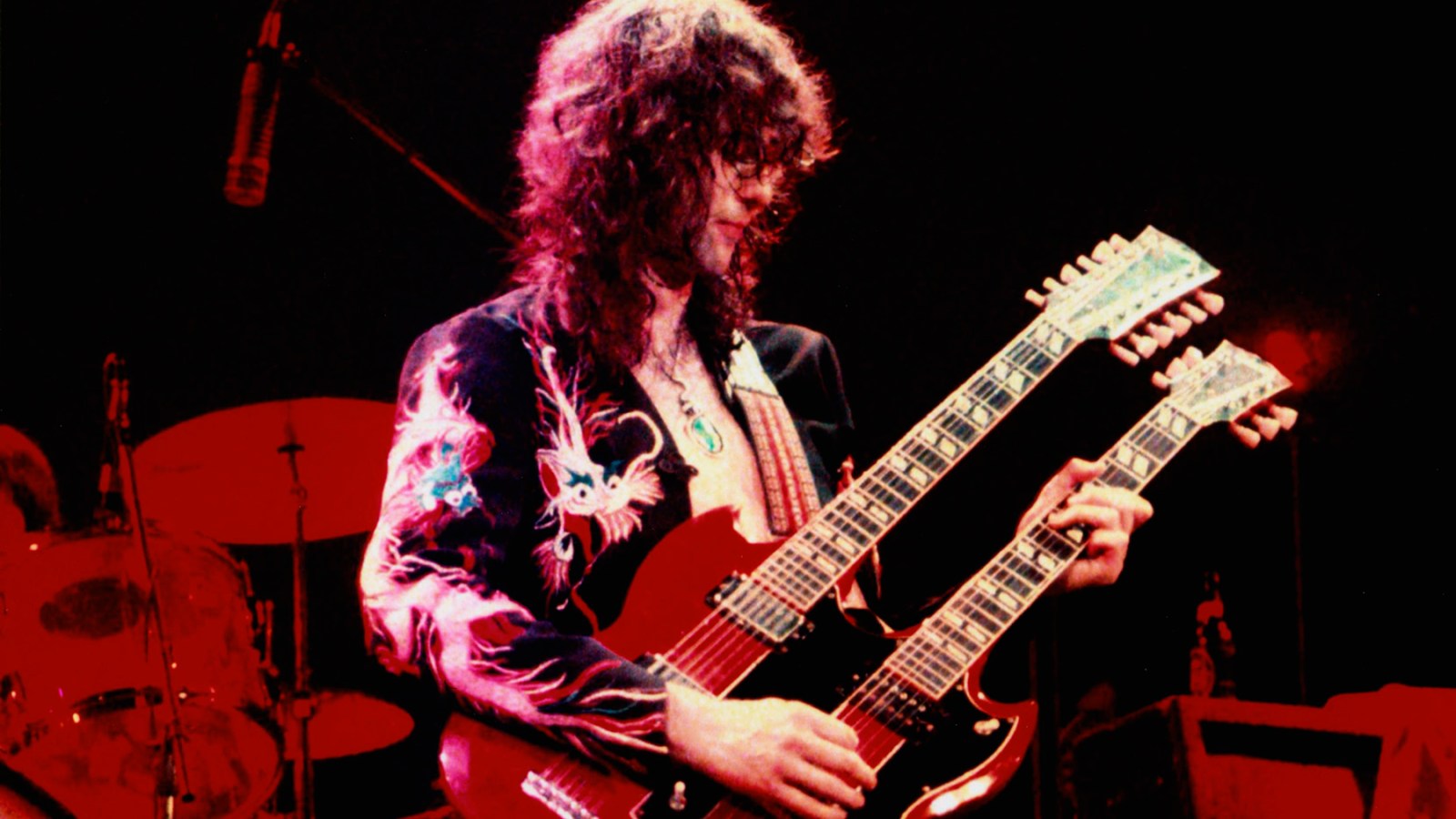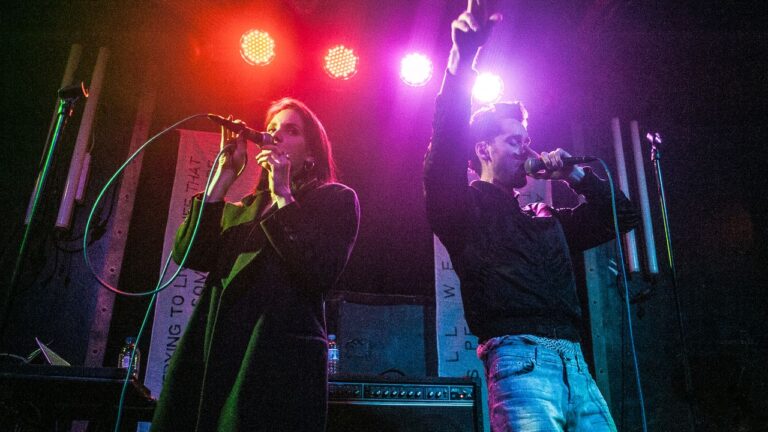By the time Led Zeppelin released Physical Graffiti in 1975, they no longer needed to prove anything. “All of us knew that it was a monumental piece of work, just because of the various paths that we’d trodden along to get to this,” says the group’s guitarist and producer Jimmy Page, in one of the music rooms at London’s Olympic Studios where the double-LP was originally mixed. “It was like a voyage of discovery, a topographical adventure.”
After refining the band’s blend of heavy-hitting blues-rock and introspective English folk on their five previous records, Led Zeppelin made Physical Graffiti their victory lap. They were now successful enough to operate their own record label, Swan Song, and the album — their first offering on the imprint — was their lengthy battle cry. Clocking in at a little over 80 minutes, Physical Graffiti contained some of their hardest-rocking tunes (“The Wanton Song,” “Custard Pie,” “Houses of the Holy”), trippiest epics (“Kashmir,” “In the Light,” “Ten Years Gone”) and sweetest rock & roll diversions (“Black Country Girl,” “Boogie With Stu”). The record showed Led Zeppelin at both their most excessive and most impressive.
Now, along with the rest of Led Zeppelin’s canon, Page has given Physical Graffiti an overhaul — remastering the original LP and compiling an album-length bonus disc of alternate mixes and early sketches of the songs on the record. Some are subtle, like the understated rough mix of “Houses of the Holy” and overdub-free version of “Trampled Under Foot” (titled “Brandy and Coke”), and others are drastic, such as “Everybody Makes It Through,” a psychedelic draft of what would become the LP’s portal to other worlds, “In the Light.”
When Page recalls the first rumblings of the album, he remembers the excitement he felt about returning to Headley Grange, the 18th century English estate where the group had recorded its landmark fourth LP. “I knew what we could do at Headley Grange after having had such a rewarding and productive experience there before,” he says. “I knew the secrets of what could be done there.”
What was it about returning to Headley Grange that excited you?
I knew how we did the drums in the main hall for [the fourth album’s] “When the Levee Breaks.” And some numbers would come out of thin air, like for example the way “Rock & Roll” did on the fourth album and then on Physical Graffiti, “Trampled Under Foot,” which came out of thin air like that, just starting out of a riff. I was basically musically salivating on the way there. I was just looking forward to the whole process of everybody being there and just having a whole run at basically working out whatever material I had had or anyone else might’ve had.
You had written music at home prior to the sessions. Were you living in Aleister Crowley’s former estate at that point?
No, I wasn’t at Crowley’s house. I lived in the countryside in Sussex, and it was a really interesting house. At the top of the house, I had a multitrack studio put in, and it gave me a chance to work on textures. I had the whole of “Ten Years Gone,” all of the guitar orchestration, prepared in that house. I came up with “The Wanton Song” and “Sick Again,” and I had the whole concept of the “Kashmir” basically there.
How did the sessions at Headley Grange begin?
It sort of kicked off with myself and John Bonham there. I had a good half-dozen things at least. And one of them — the first one that I couldn’t wait to get the drums in the hall, to get this big drum sound and then play the riff of — was “Kashmir.” I wanted to try out these ideas that I had for the cascading brass part and figure out the guitar’s pace on it. I always thought of that guitar part as being something that was augmented by the orchestra. Basically, it was just really good to start kicking it off with him, ’cause he and I worked so well together.
“This was meant to be something pretty epic and substantial.”
What were the roots of “Kashmir”?
Well, I had the ideas for the riff and the cascading part, which is actually electric 12-string and it’s brass on the record, from something that I had been working on before we even went to Headley. It was another piece of music entirely, and right at the very end of it, while I was playing along, I played the acoustic guitar part in reverse, and there was a sort of fanfare, or the cascades, followed by the riff, and I thought, “Whoa.” It just occurs right at the end. I said, “Oh, boy, I can visualize this. It’s going to be built around the drum kit, and I’m going to get in there with John Bonham.” It’s the first thing that I ran through with him, because I just know that he is gonna love it, and he loves it, and we just play the riff over and over and over, because it’s like a child’s riff. Musically, it’s a round, like “Frère Jacques,” where you can lay things on top of it. That was the idea of having this riff that was gonna be really intense, and probably pretty majestic as well, but quite intriguing. But the fact was, it was going to be built around the sound of Headley, and the drums in the hall. That’s how I heard it, and that’s how I saw it, but I also heard it with orchestra in mind.
It was the first track where we actually heard the complement of a full orchestra on top of the brass, and the strings. We’d used strings on “Friends,” on the third album, just a small string session, but this was really something that was meant to be pretty epic and substantial.
Robert Plant has attributed the lyrics to “Kashmir” to a trip you two took in Morocco. Was the riff similarly inspired?
No. It had already been taking on a really magnificent and substantial shape, and Robert said, “You know, I’ve got some lyrics that I wrote when we were in Morocco I’d like to try on this,” and that’s what he did. But that was way after the event of actually having the whole of the structure of the song.
You included a “rough orchestra mix” of the song on the new companion disc. What stands out to you about it?
The phasing of the drums isn’t apparent on this one. It’s a different mix all together, but the placement of it is really good, as far as the position on the mixing. There’s a sort of 3-D perspective, like the old 3-D films where you could actually touch things when they were coming past you. It’s more like that in a sonic picture. Everything, including the background, is in focus.
The most surprising track on the companion disc is “Everybody Makes It Through,” which became “In the Light.” How did that transformation take place?
That version is a combination of riff ideas, and the structure is made up of it. At that point in time, on “Everybody Makes It Through,” Robert is singing a guide vocal as a point of reference. It also doesn’t have the [intro] drone. It was always gonna have a drone to it, which is a bowed guitar, and you hear those sort of bowed switching on and switching in on the final version, but John Paul Jones comes in and lands this absolutely miraculous synthesizer part that opens up “In the Light.” It’s just phenomenal, and then Robert comes in and does those block vocals, which to me always sounded like some choral music that I had heard from the Music of Bulgaria. So you can hear the work that was individually put into those things.
I must say that as far as all of these extra things, the studio album versions are better, but all these other versions are really of great, significant interest, I believe.
It seems like that one developed more than some of the other songs on the album.
It just depends on whether you caught it with the first take, like “Custard Pie” or “Trampled Under Foot” even. “Trampled Under Foot” is “Brandy and Coke” on the companion disc and that’s really interesting for its energy but you can also see all the extra sort of work that goes into it as far as the overdubs. Same deal with “In My Time of Dying.” That one is, like, the full 11 minutes. There were no edits or drop-ins or overdubs to the version you hear. This is Led Zeppelin just going for it for an 11-minute song with all the changes in it and everything and the musical map that you have to remember when it goes 1-2-3-4, tapes rolling.
Why were you interested in drones at the time anyway?
Well, the drone we used at the opening of the concerts that actually came out as How the West Was Won, the ones in Long Beach and L.A. Forum, and it was just an acoustic guitar that was tracked. I used the bow going way back into the days of the Yardbirds, and a little bit before that. But it was something I took very seriously but that was on electric guitar; I wanted to get the density, if you like, of an acoustic guitar tuned into a chord and just sort of bowing and just building it up like you’d have over an orchestral thing almost or [modern classical composer] Krzysztof Penderecki. He would have liked that [laughs]. The idea of using the drone even preceded that album, but it really comes into effect there, that’s for sure. It was the early days of ambient music, if you like.
“It’s just total attitude, which is probably in my DNA.”
I’ve read that John Paul Jones said you never played “In the Light” live because it would be too hard to replicate.
We could have done it. At that point in time, I think he’s still in the position that the synthesizers were monophonic maybe. But further on down the road, maybe on the ’77 tour, we could have done it. Maybe we should have played it at the O2, because I know that the keyboards of today are more complete. But the song didn’t come into the equation; we never even took it on.
Going back to the final album, another song you had held onto from previous sessions was “The Rover.” Did that take a lot to develop?
It was something that was started when we were at Stargroves [estate] for Houses of the Holy, but it got worked on when we actually got to Headley on the second visit where we did guitar overdubs and it was mixed at Olympic. The whole thing about “The Rover” is the whole swagger of it, the whole guitar attitude swagger. I’m afraid I’ve got to say it, but it’s the sort of thing that is so apparent when you hear “Rumble” by Link Wray — it’s just total attitude, isn’t it? So that sort of thing, which is sort of probably in my DNA to be honest with you.
Why was Physical Graffiti ultimately a double-album?
It gave us the chance to put in the material that was left over from the first visit to Headley. There were three tracks that were left off of the fourth album, and that was “Boogie With Stu,” “Night Flight” and “Down by the Seaside.” If you think about it, you couldn’t have substituted anything off the fourth album with any of those tracks, quite rightly so. Each of them had their own individual charm and character.
So with those, plus the fact that “Houses of the Holy” was a track that wasn’t included on the album Houses of the Holy, that was four things straight away [to include]. And, you know, given the chance of having a good run at this writing and recording process, I didn’t want it to be a double-album with any padding on it. It would be a double-album with all character pieces, the way that Led Zeppelin did their music with the sort of ethos of it, if you like, that everything sounded different to everything else.
You also had your label to think about at the time.
It was the first [Led Zeppelin] album that was going to be on the Swan Song record label that Peter Grant had helped put together for the band with Atlantic. Having a record label was a really cool idea, because it gave us a chance to showcase people that we really liked and respected, so, as an example, Paul Rodgers’ band, Bad Company, which was one of the first releases and also, the Pretty Things, we all did highly of, and I thought what they did on Swan Song was good.
You were working on the soundtrack for Kenneth Anger’s film Lucifer Rising, which you’re reissuing soon, around that time you made Physical Graffiti, too.
Yeah, having the facility to have this multitrack at home, I could try experiments with sort of all of the instruments, giving them different treatments so they didn’t actually sound, necessarily, like the instrument itself. So the tabla drums, they don’t sound like tabla drums and there’s a big tambura that sounds pretty radically different. The version that’s coming out has got the guitar guide to it. So there was an acoustic guitar to it that I took out in many other versions. But it’s pretty interesting.
Was there any crossover between what you did with Lucifer Rising and Physical Graffiti?
I knew that that sort of stuff wasn’t necessarily the way that Led Zeppelin was going to go, although it’s still there in all. It was like my own sketchpad and I tried things out that are pretty radical. I was pushing myself, that’s what it was, in every degree in every angle.
You came up with the title “Physical Graffiti.” What was the concept behind it?
Graffiti had started to appear on buildings at the time, and usually it was quotes from William Blake, and it wasn’t in the graffiti which we know think of, which was more from the hip-hop times. Nevertheless, graffiti was appearing, and I imagined something, which was like a physical reaction to it. Since we were in a recording studio, if you’re doing a recording, and it’s going on the tape, even though its magnetic tape, that’s like a graffiti in itself. The music was a physical manifestation.
Lastly, you’ve said you’re now working on a new “guitar project,” and also that it began with playing acoustic guitar. What will it be?
I intend to be doing something which obviously will surface as a sort of album somewhere. It’ll surface further on down the line; I’m looking forward to doing whatever the project is. But if you think about all the areas that I’ve attempted, guitar, whether it’s acoustic or electric or whatever, all the different approaches that I’ve done, it’s just gonna be an extension of all of that, and that’s it. So it’s not just acoustic, it’s not just electric, it’s everything I can muster up.



